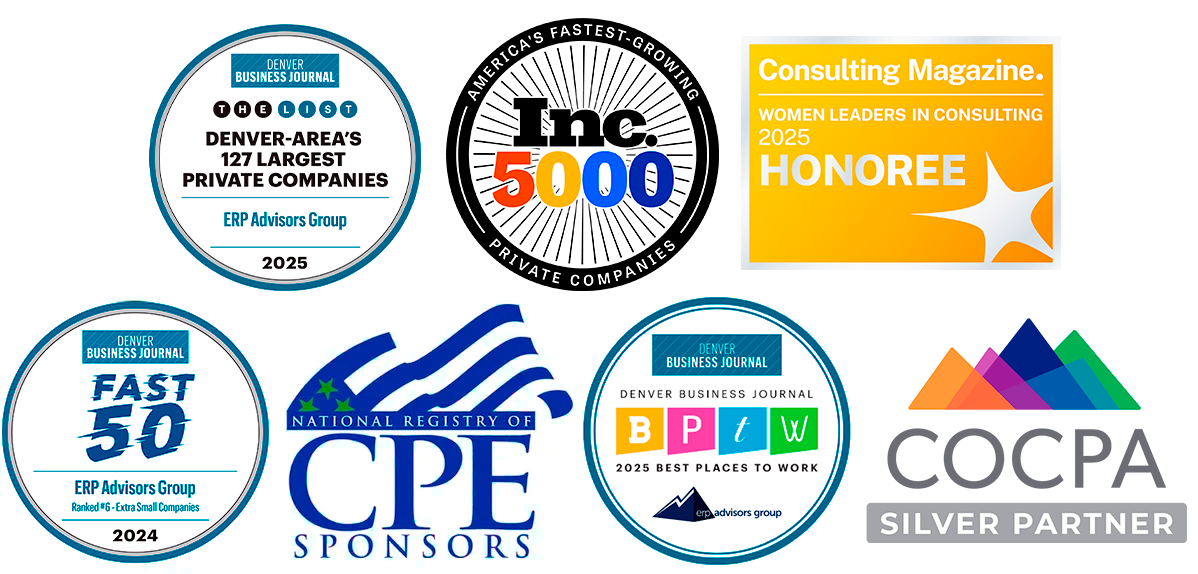
2025 has brought impactful developments in the world of ERP across all major industries. At the same time, various economic and global factors have changed what businesses need and demand from their software solutions, with even more investments focused on industry-specific needs. As a result, we expect big things across many industries in 2026. On this episode of The ERP Advisor, Shawn Windle and Rebekah McCabe break down major trends for key industries in 2025, how ERP evolved as a result, and make predictions for each industry in 2026.
2026 ERP Trends By Industry
2025 has brought impactful developments in the world of ERP across all major industries. At the same time, various economic and global factors have changed what businesses need and demand from their software solutions, with even more investments focused on industry-specific needs. As a result, we expect big things across many industries in 2026. On this episode of The ERP Advisor, Shawn Windle and Rebekah McCabe break down major trends for key industries in 2025, how ERP evolved as a result, and make predictions for each industry in 2026.
Major Industry Disruptors in 2025
2025 was a year of major global events, heavily impacting businesses across industry lines. From shifting geopolitics and economic factors such as tariffs, to increased investment by bankers and private equity, turbulence has been a recent theme in enterprise software. We are also entering a “silver tsunami” of retirements on the horizon, increasing the importance of optimizing and automating processes. These changes have driven the demand for new functionality from software vendors.
Advancements in Software
Technology development was one of the hottest topics in 2025. Artificial intelligence (AI) spearheaded the advancements, changing our perception of what enterprise software can be and do. In response to the AI catalyst, we have seen transformative developments in budgeting and forecasting tools, as well as upgrades for human capital management, payroll, and scenario planning software.
Overall, we expect 2025 to be remembered as a foundational year for the future of ERP. We are unlocking the potential of AI in business automation and shifting away from the conceptual, early-stage introductions of AI in 2024.
Key Industries in 2025 and 2026
Almost every industry was impacted by 2025’s technological landscape and will continue to evolve as we enter 2026 and businesses adopt newer solutions. In this article, we will break down some of the key industries impacted by these trends and how they will shape the landscape in 2026. If your industry is not listed below, don’t fret! Our annual ERP trends and predictions review will cover all major industries and will be released at a later date.
Manufacturing
2025:
2025 was a very difficult year for many manufacturers due to the uncertainty surrounding tariffs. Tariffs and other economic factors forced manufacturers to re-evaluate their entire supply chains and procurement processes to potentially streamline the purchasing of raw materials for production. Material requirement planning solutions have always been vital to manufacturers, but this year deepened the dependance on MRP solutions, alongside AI advancements, to help manufacturers in turbulent markets.
On top of that, the pressure to be environmentally responsible in sourcing their materials continued to swell. Finding a way to source materials responsibility became increasingly important to businesses, which further required software solutions to be more flexible in costing, planning, etc.
2026:
We expect (and hope) manufacturers catch a break after a tumultuous 2025. This will begin with a transition from being reactionary to proactive as we settle into 2026. Thanks to new technological advancements in manufacturing, manufactures should begin to see massive returns on their software investments.
Manufacturers can also expect to be impacted by the upcoming wave of retirements, especially from a technology perspective. Many manufacturers are on outdated, legacy platforms being maintained by older resources whose retirement could cripple their system. As a result, manufacturers will continue to see the pressure to upgrade to modern technology in 2026.
Distribution
2025:
2025 somewhat concluded the huge transitional period distributors have experienced over the last 10 to 20 years. They have undergone radical transitions as their historical operations have been threatened by the emergence of eCommerce titans such as Amazon, as well as an increase in manufacturer to consumer sales activity.
Ultimately, we continued to see distributors diversify by adding branches to their business model, such as field services. In doing so, they leveraged their product knowledge as a value-add differentiator, allowing them to get a leg up on direct-to-consumer manufacturers. Distributors needed to make their presence known, and software advancements in 2025 enabled them to expand their business’s offerings through greater flexibility and scalability.
2026:
Similarly to manufacturers, distributors will benefit heavily from fewer disruptions to their industry as geopolitics and economic factors slowly settle. They will be able to adjust to their new structure and really develop revenue recognition and continued revenue streams within their new model.
While we do not foresee AI playing as heavy of a role in distribution as in other industries, distributors will still continue to benefit from enhanced automation in data flows. However, at their core, we expect distributors to stay true to their new business model and focus on continuing to develop what they have been over the last two decades.
Construction
2025:
Automation was by far the biggest construction industry trend in 2025. Vendors like Procore, CMiC, and Sage expanded their investment in construction solutions, while other vendors announced end-of-life deadlines for legacy solutions like Deltek Vision.
These announcements demonstrated the largest increase in investment for construction software in recent memory. The industry has historically lagged in adopting new technologies, but 2025 saw major advancements across construction businesses looking to take advantage of new solutions, especially surrounding AI tools.
2026:
With new, more complex AI models being developed in the construction space, we expect construction companies to expand their capabilities surrounding data usage. Improved reporting and analytics tools will allow construction companies to optimize and automate their operations, expanding what businesses are capable of and allowing them to reach new heights. We anticipate construction businesses to take the leap and step above any historical “laggard” stigmas.
Energy
2025:
ERP’s macro-focus in 2025 was on the energy industry due to the gargantuan increase in demand for energy globally. AI developed at a rapid rate this year, and the energy industry made that possible by providing the power supply needed to data centers. There were major energy investments from the financial investment community in 2025 as a result. Additionally, the increase in demand and energy utilization changes have increased the need for renewable and innovative energy sources, driving growth across the industry.
2026:
The energy industry took off in 2025, and that growth trajectory is not expected to stop in 2026. The demand for energy to power computer processing is on an upward trajectory and will continue that path as technology evolves. Artificial intelligence and computing technology have reached a level of innovation and growth not seen since the telecommunications explosion in the 1990s. We can only expect for the investment into data centers and computer processing to continue its expansion, and with that comes the need for more energy. We anticipate that vendors will do what they can to support energy companies in providing the most optimized production processes possible.
Conclusion
Despite being what felt like a hectic year, 2025 laid the groundwork for incredible developments in 2026 and the years to follow. It is important to take advantage of the advancements within your industry in order to keep up with the competition and fuel future growth.
For a breakdown of our 2026 trends and predictions for other industries, stay tuned for our complete 2026 ERP Trends & Predictions report!
If you need any support evaluating what software is best for your industry based on these trends, we can help! Schedule your free consultation today with a member of our team.





